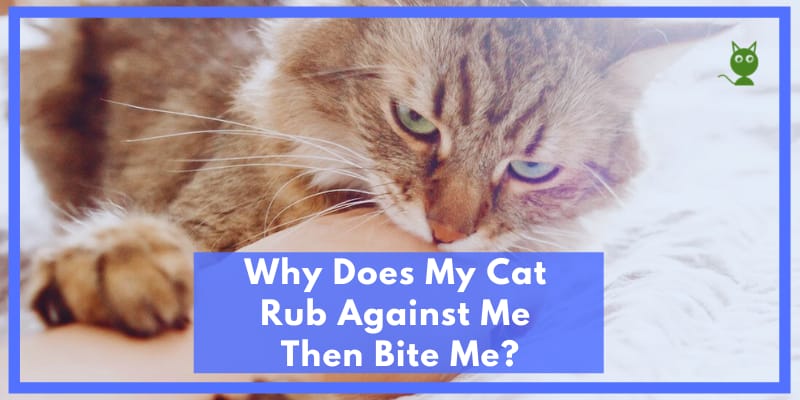
If you have experienced your cat biting you, you’ve probably wanted to know why. This question is especially common when the interaction with your cat is otherwise very loving. You may have wanted to know, “Why does my cat bite when I pet her?” or “Why does my cat bite then lick?” Cats make great companions, but sometimes their behavior can be confusing. Many cat owners have wondered, “Why does my cat rub against me then bite me?”, as this is a common feline behavior.
Just like people, cats react to their surroundings based on their emotional states. If a cat feels overstimulated or overwhelmed, the cat might react with aggression. While this is a normal response, it can also be a problem behavior. Biting can cause injury or distress to the people caring for the cat. Thankfully, this sort of aggressive behavior is never without cause.
By understanding why cats can react with aggression or what may bother our cats, we can better care for our feline friends - and avoid some extra bites and scratches along the way!
Why Do Cats Behave Aggressively?

There are many reasons a cat might behave aggressively. Some common reasons include previous experiences like a lack of socialization or trauma, current social conflict, or fear.
Cats can behave aggressively due to the following reasons:
Not enough socialization
Cats do best in new homes or with other pets if they were socialized at a young age, when they are between 2 and 14 weeks old. Cats that didn’t receive this socialization tend to be more anxious and tend to struggle to adapt to new environments. This stress can lead to aggressive behavior, which could be why your cat bites when you pet her.
Bad past experiences
Cats can also be less able to adapt when past experiences have been highly stressful.
Social conflict
Our cats don’t have control of their own environments. Instead it’s up to us to make sure they have happy homes! Some cats do better in certain environments based on their personalities. For example, some cats do well in very social environments with other pets and some do better as solo pets. Social conflict can also extend to people in the household if there is someone who doesn’t get along well with your cat.
Fear
Cats may respond with aggression if they feel threatened or trapped. This is a defensive reaction because your cat thinks there is danger.
Underlying medical issue
If your cat has a medical issue that causes them pain or distress, this could also lead to biting. This could be why your cat bites when you pet her, or bites then licks. Some example types of conditions could be dental disorders, joint disorders, spinal disk disorders, emotional issues, or a past injury. Consult with your veterinarian if you suspect your cat has a medical condition that is causing aggressive behavior. This could be the reason why your cat rubs up against you and then bites you.
When your cat bites when you pet her, this is called petting aggression. There are also certain cues cats give in body language that can tell us our cats may react with petting aggression.
Reading Your Cat’s Body Language

As a cat owner, it’s important to learn how to read your pet’s body language. Your cat may be giving warning signs that they are tense, anxious, or upset.
Ears and tail
Your cat’s ears and tail may perk up, showing that they are alert. This can indicate tension that could lead to petting aggression. Your cat might, instead, stiffen their tail and lower it or place it on the ground. This tail position means that you should give your cat some space! They don’t want to socialize right now.
Vocalizating
Your cat’s ears and tail may perk up, showing that they are alert. This can indicate tension that could lead to petting aggression. Your cat might, instead, stiffen their tail and lower it or place it on the ground. This tail position means that you should give your cat some space! They don’t want to socialize right now.
Your cat may make noise to indicate that they don’t want to be petted. This could be growling, crying, or howling.
Stance or posture
If your cat has an alert stance or gets into a hunting posture, your cat is trying to warn you that they are about to pounce.
Bluffing
Your cat may “bluff” by arching their back. This is another physical sign that your cat is feeling threatened and wants you to leave them alone for the time being.
How Do I Respond When My Cat Bites Me?

If your cat bites you, the first thing to consider is safety. You want to prevent further injury to yourself, so it’s best to leave your cat alone and stop trying to pet or interact with them. It’s important that you don’t respond aggressively. For both your cat’s and your own wellbeing, refrain from shouting or punishment. This is especially important if your cat is particularly distressed. Body language cues, like those described above, can let you know how distressed your cat is feeling.
If you can, you should separate your cat from other people, especially young children who might not understand that your cat is upset and needs to be left alone. You should also separate your cat from other pets. Once your cat has had time to recuperate and calm down (usually within a few hours), you stop isolating them. However, it’s important that you don’t initiate petting your cat. If your cat wants to be social or play with you, let them come to you. This will help your cat feel more trusting because you won’t seem aggressive or aggravating.
After a few days, gradually return to petting your cat. This will help desensitize them to touch and prevent further aggressive behavior. If your cat still bites when you pet her, it might be best to consult a professional. Consider reaching out to a veterinarian, or someone else who is trained and certified to assess and adjust cat behavior. You can also come up with some silly games to play with your cats to tire them of their energy!
If you suspect your cat is biting due to discomfort from a medical issue, consult a veterinarian immediately.
How Can I Stop My Cat from Biting?

If you have a kitten, you have an early opportunity to prevent future biting. You can make sure that your kitten knows that hands are not for biting by ceasing to pay attention to them when they bite. If your kitten is persistent, another way to discourage kittens from biting is to blow air firmly but gently into your kitten’s face.
Overall, it’s important to get your kitten used to gentle and positive touch so that, as adult cats, they will enjoy petting without becoming agitated and aggressive. Different cats prefer different kinds of touch, but they will always let you know if the way you are petting them is unpleasant! As discussed earlier, there are body language cues that may indicate your cat is about to bite. There are also additional cues that your cat may just be a little agitated, such as simply swishing their tail (rather than it being alert or low to the ground), shifting their position, or looking back at you.
If you don’t have a kitten but have an adult cat, you can also try redirection training. One example of redirection training is rewarding your cat with treats to encourage positive social behavior.
Biting behaviors may also lessen if you create a more comfortable living environment for your cat.
How to Create a Positive Environment for Your Cat

Studies have shown that aggression in cats is not natural. It is only a result of the cat’s environment that will make them act out. The most comfortable environment for your cat will provide physical and mental activity, which will help alleviate stress for bored or under-stimulated feline companions!
Hiding and Perching
Providing more access to hiding spots can help your cat feel more at ease. This could take the form of a cardboard box, or something more complex like a cat tree. A cat tree also gives your cat a perching spot, which our feline friends also love! The combination of new hiding and perching spots will help your cat feel more in control of the environment they live in. This could help prevent your cat from biting when you pet them or rubbing up against you then biting you. Having places to hide and perch are especially important in homes with multiple cats. This way, each cat gets some of their own space.
Consistent Environment
To the best of your ability, make sure that your household is predictable for your cat. Things like large parties, abruptly rearranging your house, or adding a new pet could all potentially stress out your cat. If you have to make a change, pheromone products can help prevent distress and fear in your cat. This could be particularly helpful if you have to move apartments or houses and your cat is in an entirely unfamiliar space.
Games and Toys
There are food puzzle games you can get for your cat to give them an outlet for hunting behaviors. Preferably, each day your cat will have the ability to engage in the hunting behaviors that are natural to them. If your cat has this outlet, it is less likely they will rub up against you then bite you or bite when you pet them. Certain toys, such as cat wands or catnip toys that can be chased, will also help your cat engage in normal hunting behaviors. After your cat has had enough “hunting,” give them treats to reward them for a good hunt!
Final Words
If your cat bites when you pet them or rubs up against you then bites, this doesn’t mean your cat doesn’t love you. It just means your cat has needs that aren’t quite being met! Cats never bite for no reason, so we just have to learn to understand how to help our cats feel more comfortable.
By reading a cat’s body language, we can determine if they are about to bite. We can also help the cat to find healthy ways to redirect biting and aggression. At the end of the day, learning to interpret your cat’s behavior to better meet their needs will help you be the best cat owner you can be!






